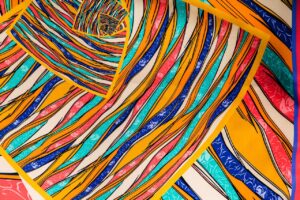An interior without fabrics?
It would lack personal character and textural oomph, and it would be too noisy.
Pillows, cushions, and throws; upholstered couches, sofas, and chairs; curtains, drapes, and blinds; table runners, rugs, and carpets; panels and partitions; wall hangings, tapestries, and even ceilings.
By using fabrics, you can completely alter your space, and you can do it on a budget.
As the most variable elements of the interior, fabrics can bring a new look for each season. For fall you can pick warm fabrics (like velvet and wool) to bring coziness, for spring and summer light fabrics (like linen and cotton), that are breathable.
There are a few key aspects you should consider when selecting them.
Mood
What is the mood you are creating? Light and bright for a playful tone? Or elegant for a sophisticated note?
Specific styles call for certain textiles.
Choosing one piece (a rug or fabric) and designing a whole story around it is a great way to proceed.

Photo Credit: Mikes-Photography, Pixabay
Color
Turn to color schemes to reach a cohesive look.
Definitely take into account the size of the room: dark colors will make a small room look and feel even smaller.
The 3 dimensions of color are: hue, value and chroma.
By hue, a color is warm or cool. What is your lifestyle? Is the room sunny or not?
By value, a color is light, medium, or dark. The best solution is to combine all of them.
By chroma, a color is muted or bright. Don’t stick with just one of these, you don’t want an environment that is too blah or too electric.

Photo Credit: Engin Akyurt, Pixabay
Pattern
A unified look should be created by gathering patterns with the same texture and color. Playing with patterns of various scales and creating flow and harmony is so much fun! A large piece can be a focal point, and smaller, quieter ones can meld interestingly.

Photo Credit: mploscar, Pixabay
Texture
Layering has been huge in interior design. Adding layers with texture brings comfort.
Balance is key. Don’t stuff your space with too many textures, but don’t keep it boring either.
A rustic setting requires more textures. On the other hand, a modern elegant interior shows smoother fabrics.
Formal fabrics (velvet, brocade, satin, damask…) are smoother and shinier.
They have a place in classic and in modern interiors as well.
Informal fabrics (tweed, bouclé, canvas…) are rough and matte.
Leather, cotton, linen, and some others belong to both categories.
What is practical for your home?
Incorporating various finishes makes the interior more intriguing.

Photo Credit: Yuri_B, Pixabay
Character
Spice it up with handmade pieces for a unique charm. Many times these items are bulkier and visually engaging. They have stories to tell about distant places, cultures, craftsmanship – humans’ passion for creation.

Photo Credit: DominiqueVince, Pixabay
Function and maintenance
Durability is of utmost importance when choosing the right fabrics. Are they for a kids’ room, a guest room, or a multipurpose living room? Are they for chairs or as window treatment? What area do they serve? Will they stand the traffic? Can you clean them easily, and how (dry-clean/machine-wash/hand-wash)?
Sustainability
In the name of environmentally friendly design, natural fibers from animals and plants (like wool, cotton, linen, silk, hemp, jute, mohair) and recycled materials have been popular in interior design. No wonder, as they are resilient, absorbent, breathable, and biodegradable.
Mixing natural fibers with synthetic ones for durability, more variety in finish, and lower costs has been an important trend.

Photo Credit: GregorQuendel, Pixabay
Curing design issues
Always take into consideration the features of the space that are already there, the walls, the floor, the furniture.
Architectural/construction mistakes can be disguised by fabrics.
Textiles can help change the perceived size of a space, make a room appear lighter or darker, and reduce the level of noise.
Certain design features can be emphasized or minimized when placing the right fabrics in the interior.
Repeating the same textiles, and balancing small-large, bright-muted, heavy-light will lead to unity.
An amazing array of fabrics are available for your decorating pleasure.
Choose wisely and transform your abode into the cozy, inviting, beautiful nest you deserve.
Photo Credit for Featured Image: Alecsander Alves, Unsplash
Julianna Kocsis is a Feng Shui Specialist, Organizational Expert, Intuitive Vibrational Catalyst, Textile Design Archivist. She is also the founder of Talila Consulting. Bringing Order and Harmony to your Home, Work and Life.
To book an appointment, contact Us: talilaconsulting.com/contact


